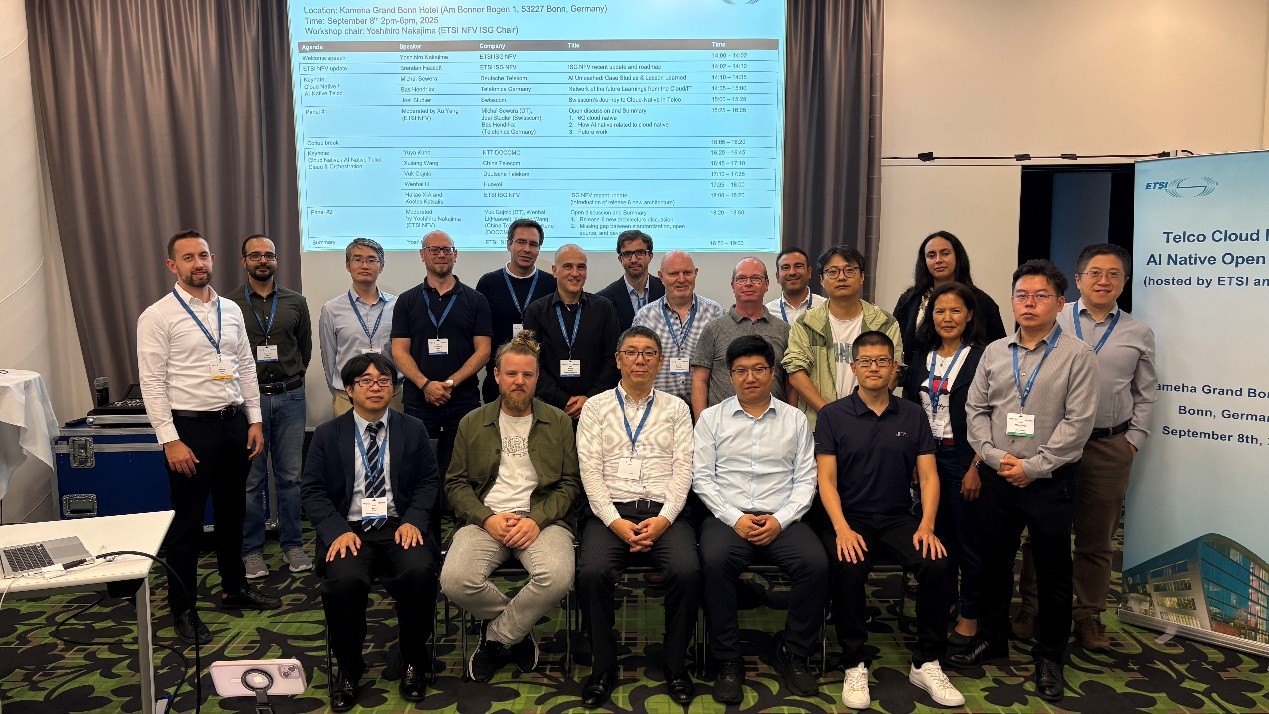Telco Cloud-Native/AI-Native Open Session in parallel with NFV#51
During the ETSI NFV#51 plenary meeting, on Monday 8 September 2025, a dedicated Telco-Cloud and AI-native Open Session was kindly hosted by Huawei in the meeting venue, Kameha Grand Hotel Bonn. Participants included European major operator representatives from Deutsche Telekom, Telefonica Germany and Swisscom, as well as ETSI NFV delegates who attended the NFV#51 meeting. The Open Session focused on how NFV standards can be adopted in alignment with telco cloud-native and AI-native trends in the telco industry, addressing challenges in automation, infrastructure agility, and operational simplicity.
Dr. Yoshihiro Nakajima, Chair of ETSI ISG NFV, provided a warm welcome speech, followed by Brendan Hassett, ETSI ISG NFV TSC chair, who provided a brief presentation of the highlights of the ETSI ISG NFV's recent releases work.
Michal Sewera from Deutsche Telekom presented several use cases related to telco system evolution towards cloud-native 5G core networks, leveraging microservices, containers, declarative management and immutable infrastructures. As discussed, the complexity of distributed systems and high-frequency changes pose significant challenges for telco-cloud networks. The transition to GitOps and AI-enabled tools for deployment, rollout and operations can be used to address these challenges by enhancing transparency, automation and fault isolation in a cloud-native environment.
Bas Hendrikx from Telefonica Germany introduced Telefonica Germany's Network of the Future program, which focused on modernising its infrastructure through cloud adoption, AI integration, and operational model transformation. The goal was to enhance network efficiency, expand service offerings, and improve customer experience through advanced automation and orchestration techniques.
Joe Studler from Swisscom demonstrated Swisscom's journey by applying a strategic approach to embracing cloud-native technologies, emphasising automation, scalability, and openness to foster a more efficient and adaptable telecommunications infrastructure.
In the second half of the session, Vuk Gojnic from Deutsche Telekom highlighted Deutsche Telekom's progress in developing a robust, scalable, and automated Telco Cloud infrastructure, emphasising its focus on open-source technologies and community collaboration for future enhancements.
Kuno Yuya from NTT DOCOMO presented NTT DOCOMO's progress in NFV, the challenges encountered, and their strategic plans for future developments, particularly in the context of 5G and the transition to a more cloud-centric operational model.
Xuliang Wang from China Telecom highlighted the evolution of network-cloud convergence, aiming to build an intelligent network system that fully integrates AI capabilities. By optimising network services, enhancing the intelligence of cloud platforms, and enabling cloud-edge collaboration and distributed data management, this approach met user needs for high bandwidth, real-time response, low latency, and security in diverse scenarios. In the future, with the in-depth development and application of AI technology, network-cloud convergence would place greater emphasis on the integration of intelligent infrastructure, the cloud migration of AI inference services, and the construction of a nationwide, efficient intelligent computing network to drive intelligent transformation across various industries.
Wenhai Li from Huawei addressed Telco Cloud platforms requiring deep integration and optimisation across hardware, software, and operations to adapt to the AI era's computing demands and business model shifts. By adopting a hyperconverged architecture, a unified NFV framework, an AI security sandbox, and an intelligent operations platform supporting AI agent applications, telco clouds would be able to achieve a transformation from cloud-native to AI-native, improving resource utilisation efficiency, business agility, and security. This transformation would drive telco cloud platforms toward greater efficiency, intelligence, and security, meeting the high-performance, low-latency, and intelligent operations requirements of future telecom services. Haitao Xia and Kostas Katsalis from ETSI IFV IFA working group concluded the presentations session with updates on the new Telco Cloud architecture standard progress in the community.
In the panel session, experts exchanged their views about cloud-native goals, gaps between standards and open source, support for AI workloads hosted by the Telco Cloud, as well as AI-enabled infrastructure.
The Open Session reinforced the message that NFV's evolution to telecom cloud would be critical for future networks. While challenges remain in automation and integration, the industry consensus is to prioritise simplification, endorse cloud-native/AI-native practices, and support backward compatibility. Success depended on collaborative standardisation and operator-led pilots to transform theoretical frameworks into deployable solutions.


